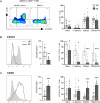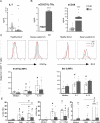Chronic activation profile of circulating CD8+ T cells in Sézary syndrome
- PMID: 29423061
- PMCID: PMC5790478
- DOI: 10.18632/oncotarget.23334
Chronic activation profile of circulating CD8+ T cells in Sézary syndrome
Abstract
Sézary syndrome (SS) is a leukemic variant of cutaneous T cell lymphoma (CTCL), and the neoplastic CD4+ T cells of SS patients undergo intense clonal proliferation. Although Sézary cells have been studied extensively, studies on adaptive immunity regarding CD8+T cells are scarce. This study aimed to investigate activation marker expression in CD8+ T cells according to the differentiation stages and IL-7/IL7Rα axis responses of patients with SS. Moreover, this study aimed to verify the soluble forms of CD38, sCD127 and IL-7 in serum. Although the SS patients of our cohort had reduced numbers of CD8+ T cells, they exhibited higher percentages of CD8+CD38+ T cells, mainly effector/memory CD8+ T cells, than the control group. In contrast, down-regulated expression of the activation markers CD127/IL-7R and CD26 was found in the CD8+ T cells of SS patients. High serum levels of sCD38 and sCD127 and scarce serum levels of IL-7 were detected, emphasizing the immune activation status of SS patients. Moreover, CD8+ T cells from SS patients exhibited IL-7 unresponsiveness to STAT5 phosphorylation and Bcl-2 expression, and IL-7 priming partially restored IFNγ production. Our findings showed a chronic activation profile of CD8+ T cells, as an attenuated cytotoxic profile and impaired IL-7 responsiveness was observed, suggesting chronic activation status of CD8+ T cells in SS patients.
Keywords: CD8+ T cells; Sézary syndrome; chronic activation markers; sCD127; sCD38.
Conflict of interest statement
CONFLICTS OF INTEREST No conflicts of interest declared.
Figures



Similar articles
-
Dysregulation of lymphocyte interleukin-12 receptor expression in Sézary syndrome.J Invest Dermatol. 2001 Jul;117(1):119-27. doi: 10.1046/j.0022-202x.2001.01354.x. J Invest Dermatol. 2001. PMID: 11442758
-
IL-7-dependent STAT-5 activation and CD8+ T cell proliferation are impaired in HIV infection.J Leukoc Biol. 2011 Apr;89(4):499-506. doi: 10.1189/jlb.0710430. Epub 2010 Dec 21. J Leukoc Biol. 2011. PMID: 21177484
-
Depressed IL-12-mediated signal transduction in T cells from patients with Sézary syndrome is associated with the absence of IL-12 receptor beta 2 mRNA and highly reduced levels of STAT4.J Immunol. 1999 Oct 1;163(7):4073-9. J Immunol. 1999. PMID: 10491012
-
Primary cutaneous T-cell lymphoma (mycosis fungoides and Sézary syndrome): part I. Diagnosis: clinical and histopathologic features and new molecular and biologic markers.J Am Acad Dermatol. 2014 Feb;70(2):205.e1-16; quiz 221-2. doi: 10.1016/j.jaad.2013.07.049. J Am Acad Dermatol. 2014. PMID: 24438969 Review.
-
The influence of HIV on CD127 expression and its potential implications for IL-7 therapy.Semin Immunol. 2012 Jun;24(3):231-40. doi: 10.1016/j.smim.2012.02.006. Epub 2012 Mar 14. Semin Immunol. 2012. PMID: 22421574 Review.
Cited by
-
T Cell Extracellular Traps: Tipping the Balance Between Skin Health and Disease.Front Immunol. 2022 Jun 20;13:900634. doi: 10.3389/fimmu.2022.900634. eCollection 2022. Front Immunol. 2022. PMID: 35795664 Free PMC article. Review.
-
CD158k and PD-1 expressions define heterogeneous subtypes of Sezary syndrome.Blood Adv. 2022 Mar 22;6(6):1813-1825. doi: 10.1182/bloodadvances.2021005147. Blood Adv. 2022. PMID: 34570200 Free PMC article.
-
The Serine Protease CD26/DPP4 in Non-Transformed and Malignant T Cells.Cancers (Basel). 2021 Nov 26;13(23):5947. doi: 10.3390/cancers13235947. Cancers (Basel). 2021. PMID: 34885056 Free PMC article. Review.
-
The CD39/CD73/Adenosine and NAD/CD38/CD203a/CD73 Axis in Cutaneous T-Cell Lymphomas.Cells. 2025 Feb 19;14(4):309. doi: 10.3390/cells14040309. Cells. 2025. PMID: 39996780 Free PMC article. Review.
-
The Tumor Microenvironment as a Therapeutic Target in Cutaneous T Cell Lymphoma.Cancers (Basel). 2024 Oct 1;16(19):3368. doi: 10.3390/cancers16193368. Cancers (Basel). 2024. PMID: 39409988 Free PMC article. Review.
References
-
- Bradford PT, Devesa SS, Anderson WF, Toro JR. Cutaneous lymphoma incidence patterns in the United States: a population-based study of 3884 cases. Blood. 2009;113:5064–73. https://doi.org/10.1182/blood-2008-10-184168. - DOI - PMC - PubMed
-
- Agar NS, Wedgeworth E, Crichton S, Mitchell TJ, Cox M, Ferreira S, Robson A, Calonje E, Stefanato CM, Wain EM, Wilkins B, Fields PA, Dean A, et al. Survival outcomes and prognostic factors in mycosis fungoides/Sezary syndrome: validation of the revised International Society for Cutaneous Lymphomas/European Organisation for Research and Treatment of Cancer staging proposal. J Clin Oncol. 2010;28:4730–9. https://doi.org/10.1200/jco.2009.27.7665. - DOI - PubMed
-
- Axelrod PI, Lorber B, Vonderheid EC. Infections complicating mycosis fungoides and Sezary syndrome. JAMA. 1992;267:1354–8. - PubMed
-
- Wilcox RA. Cutaneous T-cell lymphoma: 2014 update on diagnosis, risk-stratification, and management. Am J Hematol. 2014;89:837–51. https://doi.org/10.1002/ajh.23756. - DOI - PubMed
-
- Manfrere KC, Torrealba MP, Miyashiro DR, Oliveira LM, de Carvalho GC, Lima JF, Branco AC, Pereira NZ, Pereira J, Sanches JA, Jr, Sato MN. Toll-like receptor agonists partially restore the production of pro-inflammatory cytokines and type I interferon in Sezary syndrome. Oncotarget. 2016;7:74592–601. https://doi.org/10.18632/oncotarget.12816. - DOI - PMC - PubMed
LinkOut - more resources
Full Text Sources
Other Literature Sources
Molecular Biology Databases
Research Materials
Miscellaneous

